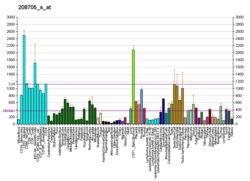EIF5
EIF5| EIF5 | |||||||||||||||||||||||||||||||||||||||||||||||||||
|---|---|---|---|---|---|---|---|---|---|---|---|---|---|---|---|---|---|---|---|---|---|---|---|---|---|---|---|---|---|---|---|---|---|---|---|---|---|---|---|---|---|---|---|---|---|---|---|---|---|---|---|
 | |||||||||||||||||||||||||||||||||||||||||||||||||||
| |||||||||||||||||||||||||||||||||||||||||||||||||||
| 식별자 | |||||||||||||||||||||||||||||||||||||||||||||||||||
| 에일리어스 | EIF5, EIF-5, EIF-5A, 진핵생물 번역 개시 인자 5, 진핵생물 개시 인자 5 | ||||||||||||||||||||||||||||||||||||||||||||||||||
| 외부 ID | OMIM : 601710 MGI : 95309 HomoloGene : 49610 GenCard : EIF5 | ||||||||||||||||||||||||||||||||||||||||||||||||||
| |||||||||||||||||||||||||||||||||||||||||||||||||||
| |||||||||||||||||||||||||||||||||||||||||||||||||||
| |||||||||||||||||||||||||||||||||||||||||||||||||||
| |||||||||||||||||||||||||||||||||||||||||||||||||||
| |||||||||||||||||||||||||||||||||||||||||||||||||||
| 위키데이터 | |||||||||||||||||||||||||||||||||||||||||||||||||||
| |||||||||||||||||||||||||||||||||||||||||||||||||||
진핵생물 번역개시인자 5는 EIF5 [5][6]유전자에 의해 인체 내에서 암호화되는 단백질이다.
레퍼런스
- ^ a b c GRCh38: 앙상블 릴리즈 89: ENSG00000100664 - 앙상블, 2017년 5월
- ^ a b c GRCm38: 앙상블 릴리즈 89: ENSMUSG000021282 - 앙상블, 2017년 5월
- ^ "Human PubMed Reference:". National Center for Biotechnology Information, U.S. National Library of Medicine.
- ^ "Mouse PubMed Reference:". National Center for Biotechnology Information, U.S. National Library of Medicine.
- ^ Si K, Das K, Maitra U (Aug 1996). "Characterization of multiple mRNAs that encode mammalian translation initiation factor 5 (eIF-5)". J Biol Chem. 271 (28): 16934–8. doi:10.1074/jbc.271.28.16934. PMID 8663286.
- ^ "Entrez Gene: EIF5 eukaryotic translation initiation factor 5".
- ^ Das S, Ghosh R, Maitra U (March 2001). "Eukaryotic translation initiation factor 5 functions as a GTPase-activating protein". J. Biol. Chem. 276 (9): 6720–6. doi:10.1074/jbc.M008863200. PMID 11092890.
외부 링크
- Nature Reviews Microbiology로부터의 상한 의존 번역 개시.개시 요인의 기능에 대한 양호한 이미지와 개요
- PDBe-KB는 인간 진핵생물 번역 개시 인자 5(EIF5)에 대한 PDB에서 사용 가능한 모든 구조 정보의 개요를 제공합니다.
추가 정보
- Das S, Maiti T, Das K, Maitra U (1998). "Specific interaction of eukaryotic translation initiation factor 5 (eIF5) with the beta-subunit of eIF2". J. Biol. Chem. 272 (50): 31712–8. doi:10.1074/jbc.272.50.31712. PMID 9395514.
- Bandyopadhyay A, Maitra U (1999). "Cloning and characterization of the p42 subunit of mammalian translation initiation factor 3 (eIF3): demonstration that eIF3 interacts with eIF5 in mammalian cells". Nucleic Acids Res. 27 (5): 1331–7. doi:10.1093/nar/27.5.1331. PMC 148320. PMID 9973622.
- Das S, Maitra U (2000). "Mutational analysis of mammalian translation initiation factor 5 (eIF5): role of interaction between the beta subunit of eIF2 and eIF5 in eIF5 function in vitro and in vivo". Mol. Cell. Biol. 20 (11): 3942–50. doi:10.1128/MCB.20.11.3942-3950.2000. PMC 85746. PMID 10805737.
- Choi SK, Olsen DS, Roll-Mecak A, et al. (2000). "Physical and functional interaction between the eukaryotic orthologs of prokaryotic translation initiation factors IF1 and IF2". Mol. Cell. Biol. 20 (19): 7183–91. doi:10.1128/MCB.20.19.7183-7191.2000. PMC 86272. PMID 10982835.
- Das S, Ghosh R, Maitra U (2001). "Eukaryotic translation initiation factor 5 functions as a GTPase-activating protein". J. Biol. Chem. 276 (9): 6720–6. doi:10.1074/jbc.M008863200. PMID 11092890.
- Wiemann S, Weil B, Wellenreuther R, et al. (2001). "Toward a catalog of human genes and proteins: sequencing and analysis of 500 novel complete protein coding human cDNAs". Genome Res. 11 (3): 422–35. doi:10.1101/gr.GR1547R. PMC 311072. PMID 11230166.
- Asano K, Shalev A, Phan L, et al. (2001). "Multiple roles for the C-terminal domain of eIF5 in translation initiation complex assembly and GTPase activation". EMBO J. 20 (9): 2326–37. doi:10.1093/emboj/20.9.2326. PMC 125443. PMID 11331597.
- Majumdar R, Bandyopadhyay A, Deng H, Maitra U (2002). "Phosphorylation of mammalian translation initiation factor 5 (eIF5) in vitro and in vivo". Nucleic Acids Res. 30 (5): 1154–62. doi:10.1093/nar/30.5.1154. PMC 101238. PMID 11861906.
- Strausberg RL, Feingold EA, Grouse LH, et al. (2003). "Generation and initial analysis of more than 15,000 full-length human and mouse cDNA sequences". Proc. Natl. Acad. Sci. U.S.A. 99 (26): 16899–903. doi:10.1073/pnas.242603899. PMC 139241. PMID 12477932.
- Marintchev A, Kolupaeva VG, Pestova TV, Wagner G (2003). "Mapping the binding interface between human eukaryotic initiation factors 1A and 5B: a new interaction between old partners". Proc. Natl. Acad. Sci. U.S.A. 100 (4): 1535–40. doi:10.1073/pnas.0437845100. PMC 149867. PMID 12569173.
- Ota T, Suzuki Y, Nishikawa T, et al. (2004). "Complete sequencing and characterization of 21,243 full-length human cDNAs". Nat. Genet. 36 (1): 40–5. doi:10.1038/ng1285. PMID 14702039.
- Gerhard DS, Wagner L, Feingold EA, et al. (2004). "The status, quality, and expansion of the NIH full-length cDNA project: the Mammalian Gene Collection (MGC)". Genome Res. 14 (10B): 2121–7. doi:10.1101/gr.2596504. PMC 528928. PMID 15489334.
- Rual JF, Venkatesan K, Hao T, et al. (2005). "Towards a proteome-scale map of the human protein-protein interaction network". Nature. 437 (7062): 1173–8. doi:10.1038/nature04209. PMID 16189514. S2CID 4427026.
- Homma MK, Wada I, Suzuki T, et al. (2005). "CK2 phosphorylation of eukaryotic translation initiation factor 5 potentiates cell cycle progression". Proc. Natl. Acad. Sci. U.S.A. 102 (43): 15688–93. doi:10.1073/pnas.0506791102. PMC 1266118. PMID 16227438.
- Conte MR, Kelly G, Babon J, et al. (2006). "Structure of the eukaryotic initiation factor (eIF) 5 reveals a fold common to several translation factors". Biochemistry. 45 (14): 4550–8. doi:10.1021/bi052387u. PMID 16584190.
- Bieniossek C, Schütz P, Bumann M, et al. (2006). "The crystal structure of the carboxy-terminal domain of human translation initiation factor eIF5". J. Mol. Biol. 360 (2): 457–65. doi:10.1016/j.jmb.2006.05.021. PMID 16781736.
- Olsen JV, Blagoev B, Gnad F, et al. (2006). "Global, in vivo, and site-specific phosphorylation dynamics in signaling networks". Cell. 127 (3): 635–48. doi:10.1016/j.cell.2006.09.026. PMID 17081983.











